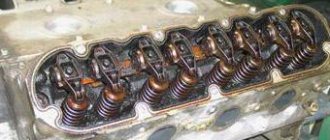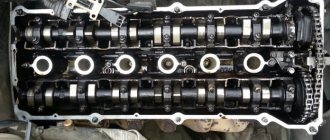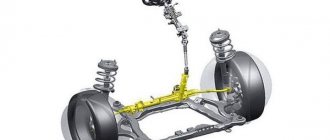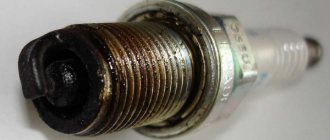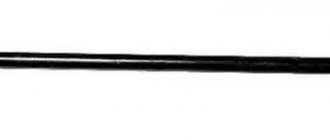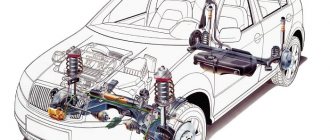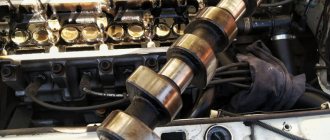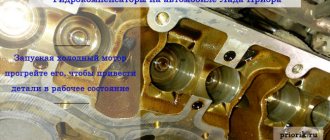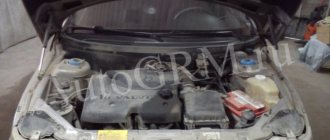Hydraulic compensators are knocking: establishing the reasons
So. Car enthusiasts with extensive experience claim that there will be no knocking on a fully operational car. And if extraneous noise appears, it means something is wrong. Why can these nodes knock?
Among the main reasons are mechanical wear or wear that forms on the surface of the plunger pair. Also, extraneous sounds may occur due to unstable operation of the valve responsible for the oil supply.
The compensators do not knock all at once. Sounds can appear due to wear or failure of even just one part.
Why the fuss
First, let's describe the possible reasons why hydraulic compensators usually knock. All of them come in two types: related to the design of the unit itself, or dependent on the supply of oil from the rest of the engine. So, let's list first the first, then the second. Malfunctions of the plunger mechanism:
- wear, defects in the surfaces of parts of the assembly;
- oil supply valve jamming;
- contamination or deposits on parts.
Also find out why valves are knocking and about replacing front shock absorbers.
Next, interruptions of the second type, when the valve hydraulic compensators knock due to poor oil supply from the engine:
- air or dirt entering the oil channel;
- oil filter clogged;
- poor operation of the oil pump;
- violation of the properties of the oil.
The consequence of all this is a knocking sound similar to the well-known valve tapping. It is a clear, mid-range metallic sound. You can also understand how hydraulic lifters knock in a car from a video from the Internet.
Also, car enthusiasts often encounter the appearance of the notorious knocking noise either only with a hot engine or only with a cold one. Let's try to differentiate the prerequisites for sounds according to these two types.
If hydraulic compensators (HC) knock, as they say, when cold, the roots of this phenomenon are as follows.
- The valve on one or several components does not hold, oil leaks, the hydraulic fluid is air-filled. But when the oil warms up, it displaces air and the sound disappears.
- The oil supply channel to the unit is clogged. As it warmed up, the clog dissolved in the oil.
- It's freezing outside and the engine oil is frozen. This is one of the main safe reasons why a problem sometimes arises on a cold engine.
- The oil filter is clogged. On a hot engine, however, the situation improved.
Basics of the design and operation of a hydraulic compensator
The negative side of the design approach is the capriciousness of the system. Very often the hydraulic compensators on the Priora 16 valves knock and the reasons for this phenomenon are unknown to the inexperienced owner. The situation becomes clearer after studying the features of the compensatory mechanism.
Configuration
The idea of automatic regulation of thermal clearances can be implemented in two versions: a conventional hydraulic pusher and a hydraulic support. The latter is used in gas distribution modules with rocker arms. On the Lada Priora in the sixteen-valve version, the intake and exhaust are equipped with individual camshafts. The optimal solution for this arrangement is the use of a hydraulic pusher.
The Priorov hydraulic compensator on the 126 engine consists of the following parts:
- A plunger pair, including a cylindrical cage and a piston with a ball valve.
- The outer housing is a pusher.
- System of grooves and holes for oil supply.
Principle of operation
The oil composition enters the internal cavity of the piston and, overcoming the resistance of the spring, pushes the ball away to fill the closed cylinder. When filling the liner, oil pushes the piston out and the hydraulic tappet rests against the cam. Next, the ball valve is locked and the assembly unit works like a regular pusher on motors with an adjustable valve mechanism.
Various causes and solutions to hydraulic compensator knocking
Next, we will look at the causes of extraneous noise in the hydraulic compensator and how you can eliminate the problem causing it.
- Extraneous sound on startup:
- reason: when the system is idle for a long time, oil leaks from some hydraulic compensators;
- elimination: a short knock of a few seconds is not a sign of a breakdown. Long lasting – has one of the reasons mentioned in the following paragraphs.
- Knocking when cold or hot, but disappears after increasing the speed:
- Reason No. 1: The check valve ball is damaged or worn. Elimination - only complete replacement of the hydraulic compensator;
- Reason No. 2: contamination of the mechanism due to low-quality or dirty oil. Elimination - cleaning the elements from wear products and changing the oil.
- Knocking when hot, but disappears after increasing the speed. There are no problems with a cooled engine:
- reason: oil leaks through the gaps between the plunger and the sleeve, which appeared due to wear. Remedy: replacing the broken hydraulic compensator assembly.
- Knock at high speeds, disappears at low speeds:
- Reason No. 1: foaming of residual oil when there is excess oil in the crankcase due to churning by the crankshaft. The resulting mixture enters the hydraulic compensators. Remedy - restore the oil level to an acceptable amount;
- Reason #2: Low oil level causes the pump to suck in air. Remedy - restore the oil level to an acceptable amount;
- Reason No. 3: The oil sump is deformed due to an impact with the road surface, which damages the oil receiver. Elimination - replacement of defective parts.
- Constant knocking of one or more valves, which does not depend on the intensity of the crankshaft:
- reason: the presence of a gap between the cam and the pusher due to damage or contamination of the mechanism elements. Remedy - check for gaps according to the example described earlier and compare the speed of movement relative to other elements of the hydraulic compensator. Clean parts from dirt and replace damaged parts.
- Knocking when cold:
- reason: rarely happens, but it does happen. This happens to varying degrees of complexity for the same reasons that were described earlier. If the knock is short-lived (a couple of seconds), this does not mean that something is broken. Troubleshooting - Troubleshooting depends on the cause and is fully consistent with the actions for knocking in other situations.
Noises when hot
Hot tapping is more systematic. It is observed even when the engine is already warmed up. The reason for the occurrence of such periodic sounds is the increased gap between the hydraulic compensator sleeve and the plunger. It occurs for the following reasons:
- wear of the hydraulic pusher parts or “sticking” of the valve through which the lubricating fluid passes;
- the use of low-quality motor oil or the wrong choice of its viscosity;
- blockage of oil channels;
- oil filter contamination;
- high air content in the engine oil and, as a result, in the hydraulic pushers themselves;
- flaring of the hydraulic pusher seating area, which expands even more when heated.
Consequences
Incorrect operation of hydraulic pushers can lead to the following problems:
- reduction in compression and engine power;
- deterioration of its launch;
- burnout of valve plates and seats;
- an increase in shock load on vehicle components and parts, which will lead to their rapid failure;
- increase in fuel consumption.
If the knocking of the hydraulic pushers disappears a few seconds after starting the engine, then in this case there is no need to talk about a malfunction of the mechanism.
Determining the source of the knock
It happens that a knock comes from the engine compartment. Only the driver may not immediately understand what exactly is the reason and who is the source of this noise. You should not immediately blame the valves, since they are not the only ones capable of making knocks.
It is quite difficult for a novice motorist, in the absence of experience in operating and repairing a car, to immediately determine what kind of breakdown or malfunction provoked the occurrence of noises and knocks. Sounds uncharacteristic of a working engine can come from bearings, belts, crankshafts, and the valves themselves. Moreover, in the latter case, we hear a fairly clear and easily audible sound, accompanied by a metallic knock. And it comes from the gas distribution mechanism.
Another characteristic feature of valve knock is that it does not stop, depending on the speed. That is, the knocking will persist when the engine is running at low speeds, and also when the driver, by pressing the gas pedal, increases the engine speed.
An ordinary driver is unlikely to be able to simply tell by ear that a valve has failed.
But still, self-diagnosis is quite possible. To do this you need to do the following:
- open the hood;
- unscrew the plug through which engine oil is poured;
- leave the engine running;
- listen; listen
- if the noise increases, the fault is in the valves;
- or take a stethoscope;
- apply the tool to the area where the noise is coming from;
- listen; listen
- draw appropriate conclusions.
This is just an approximate diagram of how to identify a breakdown and make a diagnosis practically in the field. Of course, it is often best to contact a car service center and undergo a comprehensive diagnosis. You can't joke with faulty valves.
As a consequence, you may encounter breakdown of the valves themselves, disruption of the timing belt, increased fuel and oil consumption, loss of power, and even failure of the engine itself.
The longer you ignore the problem, the more severe and expensive the consequences may end up being. If you hear a metallic knock while warming up or accelerating your car, go to a garage or service station. Don't delay diagnostics.
Hydraulic compensators and “Accent”
The reasons for the knocking are standard here. The owners write that the problem can be solved by changing the oil. More experienced owners believe that if hydraulic compensators knock when cold (Accent is no exception), this is nothing more than a feature of the engines.
But in general, most drivers change oil with a viscosity of up to 5W30, and this allows you to completely get rid of the knocking of these mechanisms in the engine.
Inlet
It happens that this hole can become clogged, but it is intended for lubricant. How does the compensator continue to work as the engine warms up? The lubricant heats up, then the gap expands. The debris that covered the holes disappears, and oil begins to flow in quantities close to normal. However, when cooling, various viscous particles will clog the hole again, which will lead to poor lubricant access. This is why hydraulic compensators knock when cold.
To fix the problem, you can try changing the oil.
Replacing hydraulic compensators on a Priora (16 valves)
For work, prepare the following tools:
- flat-head, Phillips-head screwdriver;
- socket wrenches;
- You may need a cylinder head gasket; replacing it will allow you to be safe from the fact that the spark plugs may flood the spark plugs with oil;
- sealant;
- magnet - for convenience.
- Stop the car with the handbrake. Lift the hood.
- Loosen the clamp securing the crankcase ventilation hose (main circuit).
- Disconnect the hose from the cylinder head fitting. Cover the fitting with rags to prevent any objects from getting inside.
- Remove the bracket for the wires of the injectors and ignition coils, having first unscrewed the bolts with the “10” head.
- Disconnect the throttle assembly wiring harness from the cylinder head, having first removed the fastenings with the same head.
- Let's move on to the cylinder block cover. All fifteen screws will have to be unscrewed. To do this, use the E-8 head. Please note that it is additionally secured with sealant.
- Therefore, use a plastic screwdriver to carefully pry the cover in places where there are visible gaps, and then lift it. At this point, evaluate the camshaft lobe wear. It should not be covered with chips or other signs of mechanical damage.
- Now you can check the faulty hydraulic compensators. Avoid damaging the valves of the gas distribution mechanism; handle them carefully.
- Remove the faulty hydraulics with a magnet and put new ones in their place, securing them in a level position.
- Along the way, you should inspect all parts, assessing the degree of wear. This will help to find the reasons for the wear of the hydraulics or the consequence - something that has worn out faster due to their improper operation.
- Replace sequentially. Do not forget to coat the cylinder head cover with sealant to ensure maximum adherence to the body.
- Reassemble the components in reverse order, check the operation of the new hydraulic tappets by starting the engine.
Particular attention should be paid to oil seals, as they are most susceptible to wear. The seals of the Russian manufacturer of wear-resistant auto components CS20, which specializes in the production of silicone, polyurethane and rubber spare parts, have proven themselves to be good. Detailed review follow the link.
How hydraulic compensators knock: video
Determine which element is knocking
You need to check all hydraulic compensators using this method: press it with a screwdriver. The cam of the element should face the pusher with the back of its head. In good condition, the hydraulic pusher will press with obvious force. Otherwise, the experimental element is broken.
There is another method. One by one, set all the camshaft cams to the upper position and check whether there are gaps between them and the pushers. While pushing down the element, visually compare the speed of its movement relative to the others. If a gap is detected or the rotation speed is higher than normal, disassemble the hydraulic compensator and clean it of dirt. If this does not help, replace it.
Detailed diagnostics of hydraulic compensators on Lada Priora
Sometimes, to determine the causes of knocking hydraulic compensators on a 16-valve Lada Priora engine, the thermal state of the engine alone is not enough. A set of tests makes it possible to more accurately determine the factor that causes extraneous noise.
Diagnosing the condition
One of the common complaints is knocking noise both cold and hot. However, as the speed increases, the symptom disappears. One of the following options is relevant:
- Worn or damaged ball valve. You can't do without replacing the hydraulic compensator.
- Contamination of the internals of the hydraulic fluid with wear products due to the choice of incorrect lubricant or untimely replacement. Washing the internals and changing the oil composition to a standard one eliminates the problem.
If the clatter appears only on a hot power unit and disappears at high speeds, and on a cooled unit no extraneous sounds are observed in any mode, the plunger pair has worn out. The hydraulic compensator must be replaced as an assembly.
The knocking is observed only at high speeds in any thermal state, and at idle there is silence, a problem with the oil level or in the low emulsion suction system. It is not recommended to go beyond the extreme marks on the dipstick; driving with a damaged oil receiver is also not recommended. Restoring the acceptable level resolves the problem.
For your information
- New hydraulic compensators can also tap. This usually happens after capitalization and is observed within a short period of time after the first start-up. It is not a malfunction if it does not recur during subsequent starts.
- If the hydraulic modules knock after changing the oil, the reason is the quality of the lubricant or the filter.
- The knocking of hydraulic pushers during startup should not be considered a malfunction. Over a long period of parking, the oil is drained from the working chambers and at the beginning of work the containers are filled.
Are the consequences dangerous?
What are the consequences of ignoring the fact that the hydraulic compensators on the Lada Priora 16-valve engine are knocking or neglecting to investigate the causes of the noise? At a minimum, acoustic discomfort. At the most, the camshaft cams will wear out and will have to be replaced.
Causes of problems
The knocking noises are clearly distinguishable when the unit is cold and when the engine is already warm. The reasons for cold knocking are:
- It can be caused by too thick oil, which is not heated, and therefore is poorly pumped into the compensator cavity. It happens too slowly when cold and a knocking noise occurs.
- If the compensator valve or line is clogged with dirt. Such contamination usually occurs when the oil is of poor quality, or when a timely oil change is missed. Clogging may occur due to the appearance of chips and other wear products of motor elements.
- Jammed compensator plunger. This happens due to abrasive debris getting into the oil, or natural wear of the part.
- There is a lack of oil in the engine; there is simply not enough of it for normal operation.
Now let's look at the reasons for knocking on a hot Priora:
- A jammed hydraulic compensator pair due to contamination or wear. The resulting scuffs block the movement of the plunger. The gap is not compensated for and knocking noises appear. Such a knock will be heard both with a cold and hot engine.
- Low viscosity of heated oil. When the lubricant is too liquid, it manages to flow out faster than the pump pumps it into the compensator. The leaking oil does not allow the cylinder to expand and the gaps are not compensated. The reason is poor-quality oil, or a mistake by the owner himself with the viscosity of the lubricant.
- The oil foamed due to too much oil, water getting into it, or poor quality.
- Camshaft problems.
If you hear such sounds, immediately check the oil level and color. Adjust the high or low level to normal, this may solve the problem. By the color of the oil, you can understand the degree of contamination and remember that you missed changing it. Oil mixed with water becomes gray or rusty, this will be noticeable on the dipstick.
Knock of hydraulic compensators on Lada Priora: diagnostics and troubleshooting
Lada Priora is equipped with a VAZ 21126 engine with an automatic gas distribution mechanism adjustment system. The gap between the camshaft cam and the valve stem is selected by a hydraulic tappet, the successful operation of which is ensured by the engine oil system. The mechanism allows you to avoid making various types of adjustments in the timing belt, reduces fuel consumption and increases the efficiency of the power plant. Fundamentals of the design and operation of a hydraulic compensator
Basics of the design and operation of a hydraulic compensator
Configuration
The idea of automatic regulation of thermal clearances can be implemented in two versions: a conventional hydraulic pusher and a hydraulic support. The latter is used in gas distribution modules with rocker arms. On the Lada Priora in the sixteen-valve version, the intake and exhaust are equipped with individual camshafts. The optimal solution for this arrangement is the use of a hydraulic pusher.
The Priorov hydraulic compensator on the 126 engine consists of the following parts:
- A plunger pair, including a cylindrical cage and a piston with a ball valve.
- The outer housing is a pusher.
- System of grooves and holes for oil supply.
Principle of operation
The oil composition enters the internal cavity of the piston and, overcoming the resistance of the spring, pushes the ball away to fill the closed cylinder. When filling the liner, oil pushes the piston out and the hydraulic tappet rests against the cam. Next, the ball valve is locked and the assembly unit works like a regular pusher on motors with an adjustable valve mechanism.
Why do hydraulic compensators knock on a Lada Priora with 16 valves both hot and cold or causes of noise
Successful operation of the hydraulic compensator (HC) is possible only with a constant supply of oil under pressure. The oil emulsion drainage prevention system allows you to eliminate knocking during startup. It is implemented in the form of a ball valve that closes the oil channel in the cylinder head after stopping the engine.
How the main guns knock
Some owners of Lada Priora have heard about problems with hydraulic pushers, but are not aware of the acoustic nature of the malfunction. It is not difficult to determine whether the modules are rattling: the sound will be similar to the operation of a diesel power plant. Indeed, the clatter can be compared to a running fuel injection pump of a diesel engine or a modern gasoline unit.
Tapping on cold
On the new motor, the hydraulic modules operate silently. This is explained by its ideal condition and confirms the quality choice of lubricant by the manufacturer. Deviations from factory recommendations or mediocre vehicle care require not only decoking of the piston rings in the future, but also a search for the factors that caused the piston ring to knock.
What causes the hydraulic compensators to knock on the Lada Priora 16 valves or the reasons for the knocking when cold can be the following:
- Contaminated or poor-quality oil emulsion.
- Unsuitable oil viscosity. Deviations in viscosity characteristics lead to the inability to push fluid through a small network of channels, which causes oil starvation in hydraulic compensators.
- Clogged oil system holes. A decrease in the flow area leads to a decrease in pressure in the chambers of the hydraulic module.
- Low pressure in the main oil line. Usually the oil pressure light comes on along with this.
- Jamming of the plunger mechanism due to the presence of a large layer of carbon deposits on the surfaces of the assembly unit.
- Wear of plunger pair parts. Defects in the ball valve or on the mating surfaces lead to fluid leaks from the sub-plunger space.
Eventually…
From all this it is clear that knocking when cold can occur for a variety of reasons. If the expansion joints are noisy and it doesn’t stop, then you need a replacement. But you can use modern additives, which, according to manufacturers, reduce noise levels. You can also count on an oil change to help. Now you know why hydraulic compensators knock - you can easily find and eliminate the cause yourself.
The most common malfunction of modern engines is the knocking of hydraulic compensators. There are many reasons, most of them related to the quality of the oil. This material will tell you what to do in case of this malfunction and how to deal with it.
What is a hydraulic compensator and how does a hydraulic compensator work?
A hydraulic compensator is a simple device for automatically adjusting the clearance in the valve drive, eliminating the need to disassemble the engine during its maintenance. A hydraulic compensator, in common parlance “hydrik,” is a miniature hydraulic cylinder that changes its length when engine oil is pumped inside.
The volume of oil compensates for the gap between the valve stem and the camshaft cam. Oil enters the cavity of the hydraulic compensator through a valve with a very small hole, and comes out through the natural clearances of the valve pair. How well the “hydric” works depends on the supply of oil and on the condition of the plunger pair, the absence of wear or jamming.
Life hack: hydraulic compensators for a Priora car with 16 valves, device, price
Compensators are needed for automatic valve adjustment; if they were not there, it would be necessary to adjust the valves every 10 thousand, as on 2109. On the Prior, hydraulic compensators knock under different circumstances - and this is not always a malfunction. They have a special knock, so experienced car enthusiasts will recognize it almost immediately.
A knock that comes from the engine of a Priora car is not a very good sign that should alert you. Each car needs to be approached differently. Therefore, when hydraulic compensators on a Priora knock, make proper preparations for repairs - you need to find out what is the reason for what is happening and how you can eliminate it by correcting the situation. In this article, we have collected for you the main signs: why these parts make noise, whether the car is cold or hot.
These parts have 16 valves on the Priora. (if taken as a complete set) they are not so little. The price starts from 4000 rubles and above. Replacing hydraulic compensators is labor-intensive and I don’t recommend getting into the engine yourself without experience. At a service station, such work for a Priora car will cost from 5,000 rubles and more.
The standard “hydriki” for the Priora were inherited from the “ten”. Even the catalog number testifies to this - 21120-1007300-86. A complete set will cost approximately 4,000 rubles. A set from (she collected Priora coupe, Sport and Premier), article number - 1-59718-219, sold in eight pieces, price - about 300 rubles.
Configuration
The idea of automatic regulation of thermal clearances can be implemented in two versions: a conventional hydraulic pusher and a hydraulic support. The latter is used in gas distribution modules with rocker arms. On the Lada Priora in the sixteen-valve version, the intake and exhaust are equipped with individual camshafts. The optimal solution for this arrangement is the use of a hydraulic pusher.
The Priorov hydraulic compensator on the 126 engine consists of the following parts:
- A plunger pair, including a cylindrical cage and a piston with a ball valve.
- The outer housing is a pusher.
- System of grooves and holes for oil supply.
Principle of operation
The oil composition enters the internal cavity of the piston and, overcoming the resistance of the spring, pushes the ball away to fill the closed cylinder. When filling the liner, oil pushes the piston out and the hydraulic tappet rests against the cam. Next, the ball valve is locked and the assembly unit works like a regular pusher on motors with an adjustable valve mechanism.
Noises when starting a cold car, which can provoke them
Below we discuss in detail the main most common types of abnormal noises when starting a machine when cold, as well as their possible causes:
- The sound of the engine being difficult to start. When starting off in a cold environment, a low intensity of headlight light is noted, and a sensation of sound is perceived, as if the car is starting without force. This is a symptom caused by problems with the battery (low charge or in poor condition) or the terminals (possibly making poor connections).
- “Skating” starter (“grrrrrrrrr…”). If the car starts to make friction noise between the gears when starting from a stop, there may be a problem with the starter.
- Engine noise (“chof, chof...”). If you hear a noise when starting a cold engine that sounds like “chop, chof...” and there is a strong smell of fuel inside the car, it is possible that the injectors are no longer sealed or are in poor condition. The noise that the injectors produce is very distinctive and this is due to the effect of fuel vapors escaping to the outside of the valve covers.
- Metal friction noise. It may happen that when starting the engine cold, a friction noise was heard between metal parts from the engine area. This situation may be a symptom caused by a faulty water pump. This metallic noise can occur when the water pump turbine comes into contact with the pump housing itself.
- Metallic noise (ringing) from the exhaust area. Sometimes, it may happen that some leak protector or clamp is loose or cracked. “Ringing” is produced by a metal part that has become loose or has cracks.
- Creak from inside the car. If there is a noise when starting the car when it is cold and it sounds like a squeak coming from the inside of the car, it is possible that the heating fan is in poor condition (the balance axis is probably broken or there is a lack of lubrication).
- The sound of metal sheets vibrating when starting up. The noise from vibration of metal sheets when starting is usually associated with the poor condition of the pipe protectors. These protectors can crack or break due to external factors such as temperature, mechanical stress, etc.
- Creak in the engine area. A creaking sound in the engine area when starting off may occur due to a timing belt pulley or tensioner in poor condition. This happens because the rollers or tensioners may become loose
- Intermittency or knocking noise in the engine compartment area. This noise when starting the car when cold occurs, as a rule, due to the timing chain being in poor condition (stretched or faulty). In this case, the chain cuts into the skates and produces these knocking noises, especially if the engine is not hot.
- Vibration of plastic in the engine area (“trrrrrrr…”). Vibration, changes in temperature or aging of the material can be caused by the fact that the cover that covers the engine is cracked or its supports are damaged, and, accordingly, vibrations of the plastic are heard.
- Metallic noise exactly during startup, accompanied by vibration in the body and steering wheel. This symptom can be considered if the engine pistons are in poor condition. These symptoms may lead to a more serious problem.
- A noise, as if metal was ringing at the start (“klo, klo,...”). When starting off, there may be a noise, a ringing of metal caused by a steering wheel failure. This can be caused by the steering wheel being unbalanced, causing vibrations that cause this noise. He's very characterful.
- Loud whistle in the engine compartment. Another possible noise when starting a car in cold weather is a whistle from the engine compartment, which may be caused by a defect in the exhaust manifold. A crack in this part, or a gasket in poor condition, both of which can create such a loud whistling noise.
- Engine chatter or discordant noises. There is a possibility that this kind of noise occurs in the engine when internal parts fail. As a rule, this malfunction is difficult to determine, since in order to accurately diagnose it, you need to disassemble the engine.
How to replace hydraulic compensators on Lada Priora?
The transition from adjusting washers, which were used on Soviet “eights” and “nines” to hydraulic compensators (HC), made it possible to abandon manual adjustment of the gaps. However, hydraulic compensators are installed only on 16-valve engines, so owners of 8-valve Prior and Kalin have to adjust the thermal clearances the old fashioned way, with washers. In this article we will talk about how to independently change hydraulic compensators on a 16-valve Lada Priora engine.
Tools and materials
To replace the HA you will need:
- jack;
- safety stand;
- wheel wrench;
- set of open-end wrenches;
- ratchet wrench with a set of sockets and a flexible extension;
- wrench for 10 and 12;
- flat and Phillips screwdrivers;
- clean rag;
- automotive oil-resistant sealant;
- thread locker.
What you need
Before starting work, we recommend that you carefully read the article Why hydraulic lifters knock when hot and cold. If you have hydraulic lifters knocking on a Priora, you will understand what to do. After all, replacing hydraulic compensators is a rather complicated matter, so it is better not to touch the timing belt unless unnecessarily necessary, because incorrect alignment of the crankshaft and camshaft marks can lead to a drop in engine power and damage to the valves. If you decide to change hydraulic compensators, then read about safety precautions for car repair and maintenance in order to responsibly approach wheel removal and work under the car.
Replacing hydraulic compensators
Below are step-by-step instructions that will help you replace hydraulic compensators on a Priora.
- Open the hood, let the engine cool and disconnect the battery.
- Jack up the front right side of the car, install a safety stand, and remove the front right wheel.
- Remove the plastic casing covering the injector, the air filter pipe, and the filter itself.
- Remove the spark plug wires.
- Loosen the two bolts securing the generator and remove the belt from it. If the car has air conditioning, then remove the belt from it too.
- Unscrew all the bolts of the intake manifold (receiver) and remove it. One of the mounting bolts is located under the generator and can be unscrewed using a ratchet and a flexible extension. If you cannot remove the receiver, then follow the next step and then remove the receiver.
- Unscrew and remove the fuel rail and injectors. Plug the nozzle holes with clean cloths.
- Remove all ignition coils.
- Align the crankshaft and both camshafts to the marks.
- Unscrew the tensioner roller bolts and loosen the eccentrics to remove the belt.
- Remove the belt, then unscrew the camshaft gear bolts. Don't lose the shaft keys, they are very small.
- Unscrew the valve cover bolts and remove it.
- Unscrew the bolts of the upper head plate, including the bolts located under the camshaft gears, and remove it.
- Remove the camshafts and replace their seals if necessary.
- Using a magnet, pull out the hydraulic compensators and insert new ones in their place, or replace the faulty one if you know which one it is.
- Clean the valve cover and top head plate of sealant.
- Place the shafts in place and turn so that the cams of the first cylinder are facing up and slightly towards each other.
- Wipe the cylinder head and top plate with a clean rag, then apply new sealant and install the plate onto the head.
- Apply thread locker to the bolts, screw in and tighten with a force of 2 kgf•m (20 N•m).
- Wipe the top surface of the stove and the valve cover with a clean rag, then apply sealant and install the cover in place.
- Apply thread locker to the bolts, screw on the cover and tighten the bolts with a force of 2 kgf•m (20 N•m).
- Install the camshaft gears and tighten their bolts with a force of 7–8 kgf•m (70–80 N•m).
- Align the camshaft and crankshaft gears to the marks and put on the belt.
- Adjust the belt tension using the roller eccentrics and tighten their bolts with a force of 4 kgf•m (40 N•m).
- Check the marks on the camshafts and crankshaft; if everything is fine, turn the engine two revolutions of the crankshaft and check the marks again. If everything is fine, then continue assembling the motor; if not, align the gears to the marks.
- Install the injectors, ramp and receiver, tighten their bolts with a force of 2.5 kgf•m (25 N•m).
- Install the air filter and its pipe.
- Connect all wires and ignition coils.
- Install the decorative plastic cover.
- Put on and tighten the wheel.
- Connect the battery.
- Start the engine. At first, the hydraulic compensators should knock, but after 3-5 minutes the knock should completely disappear. If the sound disappears, you did everything right. If not, then something was wrong.
How to eliminate the knocking of hydraulic pushers on Lada Priora
Timely and high-quality maintenance of the engine oil system is the key to flawless operation of the hydraulic compensator mechanism. After all, the unit is designed for use throughout the entire resource of the power plant.
Use of recommended lubricant
When the hydraulic pushers just start knocking, the manufacturer recommends changing the lubricant to a proven option. Therefore, when the question arises of what kind of oil to pour in principle, it is worth analyzing reviews to determine the acceptability of a certain model of oil product for hydraulic compensators.
Of course, the best choice for Lada Priora will be the composition recommended by the manufacturer, specified in the instruction manual. However, not all current popular products are included in the list.
An analysis of opinions shows that, indeed, with the universal viscosity of 10W-40 or 5W-40 specified by the factory, not every oil is suitable. For example, Shell Helix Ultra 5W-40 causes knocking already at 15,000 km, while on Liqui Moly Optimal Synth 5W-40 the hydraulics are silent even at 80,000 km.
Reviews show that it is optimal to choose the following lubricants:
- Total Quartz 9000 Energy 5W-40.
- Mobil Ultra 10W-40.
- Wagner Windigo 10W-40.
Flushing
Many owners, in advanced cases, resort to general engine flushing. However, the effectiveness of such an event in the fight against knocking GCs is low. This is explained by poor oil pumpability in the area of the hydraulic pusher chambers.
If changing the lubricant does not help, the best solution is to remove the cylinder head cover and find which hydraulic compensators on the Lada Priora 16-valve engine are knocking and determine the reason for this. Defective parts are identified by diagnosing running resistance with a wooden wedge. A fast movement speed in comparison with other hydraulic supports indicates wear of the hydraulic module, the presence of a constant gap indicates its coking.
Attention! The wooden wedge must be pressed against the non-working surface of the cams.
Effective removal of carbon deposits inside the cylinders is their local washing. Worn assembly modules cannot be repaired.
Additives
Additive compounds help delay identifying the causes and cleaning the timing belt. There are several products available in the market. The most popular products are from Liqui Moly and XADO. The effectiveness of substances depends on the specific case. Fans of motor additives often equate this class of chemistry with a waste of money.
Hydraulic lifters rattled on the Priora, what should I do?
Lada Priora is equipped with a VAZ 21126 engine with an automatic gas distribution mechanism adjustment system. The gap between the camshaft cam and the valve stem is selected by a hydraulic tappet, the successful operation of which is ensured by the engine oil system. The mechanism allows you to avoid making various types of adjustments in the timing belt, reduces fuel consumption and increases the efficiency of the power plant. Fundamentals of the design and operation of a hydraulic compensator
Knocking after replacement
Usually new parts don't knock.
If you still hear sounds, then this is a manufacturing defect or a problem with the valves. In order to perform an accurate diagnosis and make sure that there is nothing wrong with the valves, it is necessary to check their fastenings. There is a possibility that the parts did not shrink as required. We simply tighten them and thereby remove the knock of the hydraulic compensator.
Sources
- https://maslo-5w30.ru/avto/stuchat-gidrokompensatory-priora-16-klapanov-prichiny
- https://medwegonok.ru/dvigatel-lada-priora-16-klapanov-stuchit-gidrokompensator/
- https://avtonomnaya-gazifikaciya.ru/dvigatel/pochemu-stuchat-gidrokompensatory-na-priore.html
- https://zsm-miass.ru/polomki-i-remont/gidriki-na-prioru.html
- https://avtonomnaya-gazifikaciya.ru/dvigatel/kompensatory-priora.html
- https://medwegonok.ru/stuk-gidrokompensatorov-priora-16-klapanov-kak-ustranit/
- https://AvtoSotka.ru/motor/stuk-gidrokompensatorov-na-holodnuyu-priora.html
